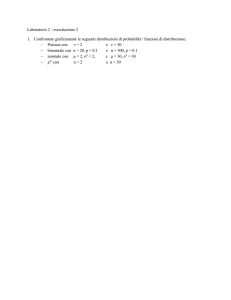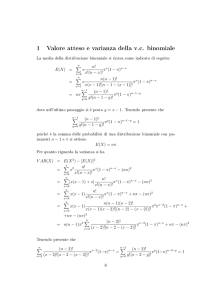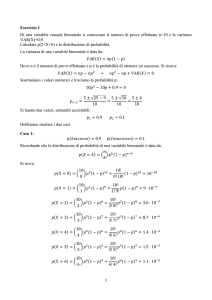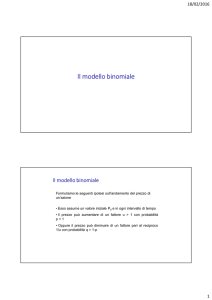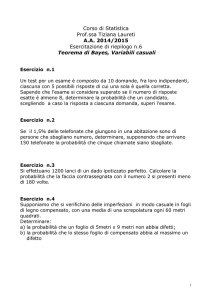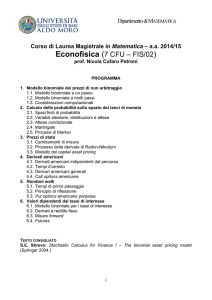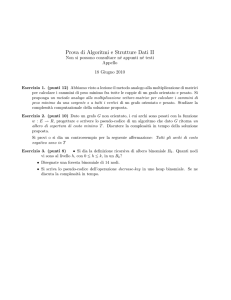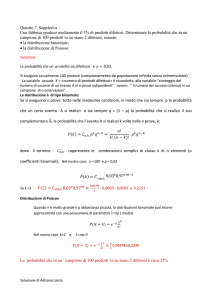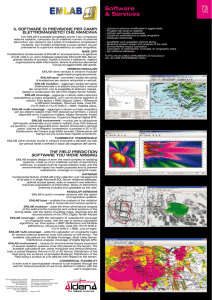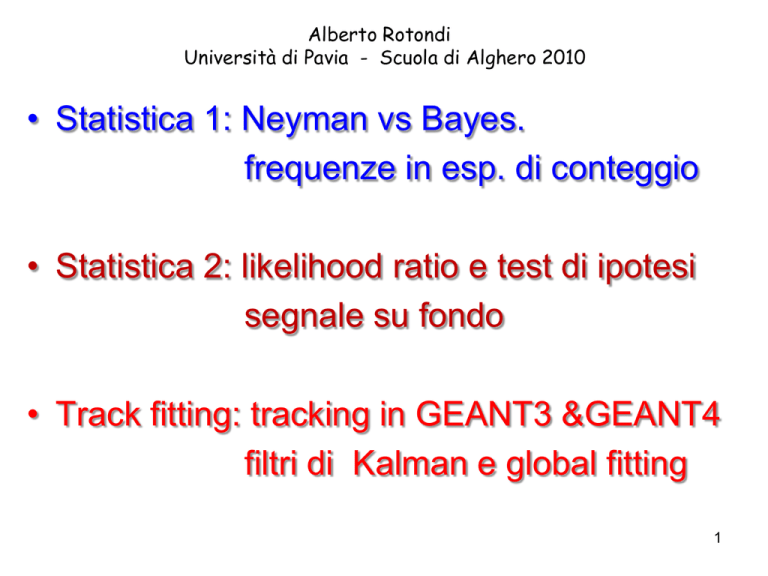
Alberto Rotondi
Università di Pavia - Scuola di Alghero 2010
• Statistica 1: Neyman vs Bayes.
frequenze in esp. di conteggio
• Statistica 2: likelihood ratio e test di ipotesi
segnale su fondo
• Track fitting: tracking in GEANT3 &GEANT4
filtri di Kalman e global fitting
1
2
2
3
4
PHYSTAT 05 - Oxford 12th - 15th September 2005
Statistical problems in Particle Physics, Astrophysics and Cosmology
5
6
7
8
Frequentist
confidence
intervals
x
9
True value
CL
x
x1
x= x1
P
< <
x
x2
Possible
interval
x= x2 < < 2
1<
<
1<
< 2) = P(x1 < x<x2) = CL
2
when x1 < x <x2
10
NEYMAN
INTEGRALS
x
Elementary statistics
may be
WRONG!!
x
11
Because P{Q} does not
contain the parameter!
12
Estimation of the sample mean
since
Due to the Central Limit theorem we have a pivot quantity
when N>>1
Hence:
13
Hence, we have three methods to find confidence
intervals with the Neyman (frequentist) technique:
• Graphical method (Neyman band)
•Analytic with the Neyman Integrals
(Clopper Pearson method)
• Inversion method (pivot variable)
x
x
14
Counting experiments
P
|x
|
[ x]
t
CL
CL is the asymptotic probability the interval will contain the true value
COVERAGE is the probability that the specific experiment does contain
the true value irrespective of what the true value is
On the infinite ensemle of experiments, for a continuous variable Coverage
and CL tend to coincide
In counting experiments the variables are discrete and CL and Coverage
do not coincide
What is requested is the minimum overcoverage
Counting experiments: Binomial case
P
|F
p|
[ p]
t
P
|F
p|
t
p(1 p)
n
CL
t=1, area 84%
Quantile =0.84
P[|f-p|<t ]= 68%
t is the quantile of the normal distribution
| f p|
p (1 p )
n
f
|t |
n
p
1
p
f
t2
2n
t
4n 2
2
t
t2
1
n Wald
t
f (1 f )
n
f (1 f )
n
t2
1
n
t
Wilson interval
(1934)
Wald (1950)
Standard in Physics
16
Counting experiments: Poisson case
Wilson interval (1934)
P
|x
|
t
CL
x
t2
2
t
t2
x
4
Wald (1950)
Standard in Physics
x
x t
x
17
Why to complicate all this?
18
Why to complicate all this?
n
1
f
t
f (1 f )
n
n=20
19
p1
p2
p
20
The 90% CL gaussian upper limit
90% area
10% area
1.28
Observed
value
Meaning I: with this upper limit, values less than the
observed one are possible with a probability <10%
Meaning II: a larger upper limit should give values less
than the observed one in less than 10% of the experiments
Meaning III: the probability to be wrong is 10%
21
22
23
The trigger problem
P(T | ) 0.95 prob. for a muon to give a trigger
P(T | ) 0.05 prob. for a pion to give a trigger
P( )
0.10
prob. to be a muon
P( )
0.90
prob. to be a pion
P( | T )
prob. that the trigger selects a pion
P( | T )
prob. that the trigger selects a muon
The probability to be a muon after the trigger P( |T):
P( | T )
P(T | ) P( )
P(T | ) P( ) P(T | ) P( )
0.95 0.10
0.95 0.10 0.05 0.90
0.678
10.000 particles
prior
9000
1.000
trigger
8550
450
trigger
950
enrichment 950/(950+450) = 68%
Efficiency (950+450)/10.000 = 14%
50
26
27
28
29
30
Bayesian credible interval
31
n 2
32
33
34
+
Bayesians
vs
Frequentists
35
Why ML does work?
hypothesis
observation
36
37
)
38
ln e
1 (x
2
)2
1 (X
2
)2
2
2 ln L( X ; )
2
( )
Gaussian variables: ML corresponds to Minimum
2
39
The weighted average
Consider the well-known weighted mean:
2
( x1
( )
)2
( x2
2
1
)2
2
2
2
,
( )
0
x1
x2
2
1
2
2
1
1
2
1
2
2
A simple algebraic manipulation gives the recursive form
(Kalman filter):
x1
x2
2
1
2
2
1
2
1
1
2
2
2
1
2
1
2
2
2
2
x1
x2
2
1
2
2
x1
2
2
2
1
x2
2
2
2
1
x1
2
1
2
1
Kalman= the measurement is weighted
point
weight following)
matrix
withmeasured
a model prediction
(track
2
2
x2
x1
prediction
40
Gaussian variables:
weighted average = Bayes (uniform) = Likelihood
41
Elementary example
20 events have been generated and 5 passed the cut
What is the estimation of the efficiency with CL=90%?
x=5, n=20, CL=90%
Frequentist result:
n
n
k x
k
x
n
k
1
1
)n
k
0.05
x
k
2
k
k 0
(1
(1
n
2)
k
0.05
1,
2
=[0.104, 0.455]
Bayesian result:
p2
x
(1
p1
1
0.90
x
0
What meaning??
)n x d
(1
)
n x
d
1,
2
=[0.122, 0.423]
42
Efficiency calculation: an OPEN PROBLEM!!
t2
2n
f
t2
f (1 f )
4n 2
n
t2
1
n
t
t2
1
n
n
1
f
n
n
k x
k
n
x
k
2
k
k 0
k
1
(1
(1
1
2
)n
)n
t
f (1 f )
n
k
/2
k
/2
p2
x
(1
)n x d
p1
1
CL ?
x
0
(1
)n x d
Wilson interval (1934)
Wald (1950)
Standard in Physics
Exact frequentist
Clopper Pearson (1934) (PDG)
Bayes.This is not frequentist
but can be tested
43
in a frequentist way
Coverage simulation
x = gRandom → Binomial(p,N)
→x
1-CL =
n
n
k x
k
x
n
k 0
k
p1k (1 p1 ) n
p2k (1 p2 ) n
k
k
/2
/2
Tmath:: BinomialI(p,N,x)
p1
p1
p2
p2
p
k++
=k/n
0ne expects ~ CL
44
Simulate many x with a true p
and check when the intervals
contain the true value p . Compare
this frequency with the stated CL
CL=0.95, n=50
45
Simulate many x with a true p and check when the intervals contain
the true value p . Compare this frequency with the stated CL
CL=0.90, n=20
46
In the estimation of the efficiency (probability)
the coverage is “chaotic”
The new standard (not yet for physicists)
is to use the exact frequentist or the formula
2
2
f
t /2
f (1 f )
t /2
t /2
f
1/ n
x
n
,
[
p
,
1
],
p
(
1
CL
)
2
1
1
4
n
n
2n
,
2
2
x 0, [0, p2 ], p2 1 (1 CL)1/ n
t /2
t /2
1
1
n
n
x / n, t / 2 gaussian,1-CL α , t 1 is 1
The standard formula
f
t
f (1 f )
n
should be abandoned
BYE-BYE
47
A further improvement:
The continuity correction is equivalent to
The Clopper-Pearson formula
2
f
t
2
t /2
f (1 f )
t /2
t /2
f
x n, [ p1 ,1], p1 (1 CL)1/ n
4n 2
n
2n
,
2
2
x 0, [0, p2 ], p2 1 (1 CL)1/ n
t /2
t /2
1
1
n
n
( x 0.5) / n, f ( x 0.5) / n,
/2
gaussian,1-CL α , t 1 is 1
This should become the standard
formula also for physicists
48
Correzione di continuità
Quando una distribuzione discreta (come la binomiale) è approssimata con una continua
(come la gaussiana), l’area del rettangolo centrato su un valore discreto x= della
variabile, che rappresenta la probabilità P( ), può essere stimata con l’area sottesa
dalla curva continua nell’intervallo [ 0.5≤x≤ +0.5]
Binomiale (istogramma a rettangoli)
Gaussiana (curva continua)
La probabilità binomiale per x= =7
è stimata mediante l’area sottesa
dalla curva normale approssimante
nell’intervallo [6.5 ≤x≤ 7.5]
6.5 7 7.5
Ciò equivale a considerare il valore discreto della variabile come
il punto medio dell’intervallo [ 0.5 , +0.5]
Se la probabilità si riferisce a una sequenza di valori discreti - cioè è richiesta la
probabilità P( 1)+P( 2)+…+ P( k) - questa si può approssimare con la probabilità
gaussiana nell’intervallo [ 1 0.5 ≤x≤ k+0.5]
Più in dettaglio, ecco come operare la correzione di continuità per diversi valori cercat
Valore della probabilità
binomiale
P(x= )
P(x≤ )
P(x< )
P(x≥ )
P(x> )
P( 1≤x≤
P( 1<x<
Intervallo su cui
stimare
la probabilità gaussiana
[
0.5≤x≤ +0.5]
[x≤ +0.5]
[x≤
[x≥
[x≥
0.5]
0.5]
0.5]
k)
[
1
0.5 ≤x≤
k+0.5]
k)
[
1
0.5 ≤x≤
k
0.5]
L’approssimazione gaussiana alla binomiale si rivela particolarmente utile per n»1
(fattoriali grandi nei coefficienti binomiali), e se si sommano le probabilità per una lun
sequenza di valori. La correzione di continuità consente di migliorare l’approssimazione
Esempio
a) Trovare la probabilità che esca Testa 23 volte in 36 lanci di una moneta
La distribuzione richiesta è una binomiale con n=36, p=q=1/2. La variabile è =23
La probabilità binomiale è:
P(
)
n!
p qn
!(n !)
36! 1
23!13! 2
23
1
2
13
3.36%
Approssimazione di Gauss con =np=36 1/2=18 e =√npq=√36 1/2 1/2=3
Tenendo conto della correzione di continuità, i due valori della variabile standardizzat
corrispondenti agli estremi dell’intervallo di integrazione [22.5, 23.5] sono:
z1
22.5 18
1.50
3
z2
23.5 18
1.83
3
Pertanto la probabilità binomiale che esca Testa 23 volte, con l’approssimazione
di Gauss, può essere stimata in questo modo:
P 1(
≤z≤1.50 )=43.32%
P 2(
≤z≤1.83 )=46.64%
P(
≤z≤1.83 )=
P 2 P 1 =3.32%
Il valore è abbastanza vicino a quello calcolato esattamente con la binomiale
Nota: per un dato valore della variabile , la probabilità con l’approssimazione
di Gauss si può anche stimare dal valore assunto dalla densità normale per x=
Il valore di probabilità di una distribuzione continua per uno specifico valore della
variabile è zero, come abbiamo visto. In questo caso però stiamo semplicemente
approssimando il valore di una distribuzione discreta (la binomiale) con il valore
assunto per quel valore dalla curva normale.
Pertanto possiamo porre:
Pbin (
) f G(x
)
1
(x ) 2 / 2
e
2
2
Nel caso dell’esempio:
Pbin (
)
1
(23 18) 2 / 2 3 2
e
3 2
0.1330 0.2494 0.0332 3.32%
che coincide con il valore trovato valutando l’area nell’intervallo [22.5, 23.5]
b) Trovare la probabilità che esca Testa almeno 23 volte in 36 lanci
Con l’approssimazione di Gauss, dobbiamo trovare la probabilità normale nell’intervallo
[22.5, ∞], che stima la probabilità binomiale che Testa esca 23 o più volte
P (z≥1.5)=50% P (
≤z <1.5)=50% 43.32%=6.68%
N=50 CL=0.90
53
N=50 CL=0.95
54
The likelihood ratio method
( p, x )
L( p, x )
L( pbest , x)
2 ln ( p, x)
Maximize
L( pbest , x)
2 ln
L ( p, x )
Minimize
55
Binomial Coverage simulation
max likelihood constraint
Feldman & Cousins, Phys. Rev. D 57(1998)3873
UNIFIED method
N!
p k (1 p) N k CL ,
k )!
k A k!( N
A k | k 0, and 2 ln ( p, N , k )
f
2 ln ( p, N , x) 2 ln
p
2 ln ( p, N , x)
1 f
x) ln
1 p
(N
56
k
n
k
N=50 CL=0.90
57
N=50 CL=0.95
58
N=20 CL=090
59
The problem persists also
with large samples!
0.95
0.90
0.86
60
N=20 CL=0.90
61
From coin tossing to physics:
the efficiency measurement
ArXiv:physics/0701199v1
Valid also for
k=0 and k=n
62
N=20 CL=0.90 Interval amplitude
likelihood
frequentist
Wilson cc
Wilson
63
x
N=20 CL=0.90 Interval
limits
64
x
(2001)
f
t2
2n
t2
1
n
t
t2
4n 2
f (1 f )
n
t2
1
n
n
1
f
n
x
k 0
x
k 0
k
n
k
f (1 f )
n
t
k
2
(1
k
2
(1
2
)n
2
)n
/2
k
k
/2
65
Counting experiments: Poisson case
(x
)
t
x
x
t2
2
x t
t2
x
4
t
x
Wilson interval (1934)
Wald (1950)
Standard in Physics
k
x
2
e
k!
k 0
2
/2
k
1
e
k!
k x
2
/2
1
e
x!
d
e
x!
d
x
1
CL ?
x
0
Exact frequentist
Clopper Pearson (1934) (PDG)
Bayes.This is not frequentist
but can be tested
66
in a frequentist way
Poissonian Coverage simulation
CL=68%
67
Poissonian Coverage simulation
CL=90%
68
The Neyman-FC integrals
Neyman integrals
q1
x
q2
p ( x; ) CL ,
k
A
A
k|k
0, and 2 ln ( , k )
L( best , x)
2 ln ( , x) 2 ln
L( , x)
2 ln ( , x)
minimize
70
Poissonian Coverage simulation
max likelihood constraint
Feldman & Cousins, Phys. Rev. D 57(1998)3873
k
k A
k!
e
CL
e / n!
2 ln
(
n
n
n e / n!
n
2 ln ( , n)
n) n ln
n
71
k
n
k
Poissonian Coverage simulation
k
k A
k!
k
e
CL A
k:
k!
n
e
n!
e
CL=68%
72
Poissonian Coverage simulation
CL=90%
73
Counting experiments: new formula for the
Poisson case
(x
)
t
x
t2
2
t
x
t2
4
x
x
0.5
Wilson interval with Continuity correction
gives the same results as …
x
x
2
k 0
x!
e
2
/2
Exact frequentist
Clopper Pearson (1934) (PDG)
x
1
k x
x!
e
1
/2
74
75
76
The Unitarity Triangle
d
s
b
u
Vud
Vus
Vub
c
Vcd
Vcs
Vcb
t
Vtd
Vts
Vtb
t
V V
• Quark mixing is described
by the CKM matrix
• Unitarity relations on matrix
elements lead to a triangle
in the complex plane
I
A=( , )
VtdVtb*
VcdVcb*
*
ud ub
*
cd cb
VV
VV
*
VudVub
*
VcdVcb
VtdVtb*
0
B=(1,0)
C=(0,0)
CP Violation
1
77
Luca Lista
Statistical Methods for Data
Analysis
78
A Bayesian application: UTFit
• UTFit: Bayesian determination of the
CKM unitarity triangle
– Many experimental and theoretical inputs
combined as product of PDF
– Resulting likelihood interpreted as Bayesian
PDF in the UT plane
• Inputs:
– Standard Model experimental measurements
and parameters
– Experimental constraints
79
Combine the constraints
• Given {xi} parameters and {ci} constraints
• Define the combined PDF
– ƒ( ρ, η, x1, x2 , ..., xN | c1, c2 , ..., cM ) ∝
∏j=1,M ƒj(cj | ρ, η, x1, x2 , ..., xN)
∏i=1,N ƒi(xi)⋅ ƒo (ρ, η)
=
A priori PDF
– PDF taken from experiments, wherever it is possible
• Determine the PDF of (ρ, η) integrating over the
remaining parameters
– ƒ(ρ, η) ∝
∫ ∏j=1,M ƒj(cj | ρ, η, x1, x2 , ..., xN)
∏i=1,N ƒi(xi)⋅ ƒo (ρ, η)
Luca Lista
Statistical Methods for Data
Analysis
=
80
Unitarity Triangle fit
68%, 95%
contours
Statistical Methods for Data
Analysis
81
PDFs for
Luca Lista
and
Statistical Methods for Data
Analysis
82
Projections on other observables
Luca Lista
Statistical Methods for Data
Analysis
83
A Frequentist application: RFit
• RFit: to choose a point in the
plane,
and ask for the best set of the
parameters for this points. The 2
values give the requested confidence
region.
• No a priori distribution of parameters
is requested
84
ln e
1 (x
2
)2
1 (x
2
)2
2
2 ln L( x; )
2
( )
85
86
87
88
Conclusions
• The
usual formulae used by physicists in counting
experimets should be abandoned
• By adopting a practical attitude, also bayesian
formulae can be tested in a frequentist way
• frequentism is the best way to give the results
of an experiment in the form
x
but other forms are also possible
• physicists should use Bayes formulae to parametrize
the previous (th or exp)
knowledge, not the ignorance
89
Quantum Mechanics:
frequentist or bayesian?
Born or Bohr?
|
2
| dx
The standard interpretation is
frequentist
90
END
91
x
Neyman integrals
Bootstrap
F ( x; ) 1 F ( ; x)
Search for pivotal variables
This method avoids the graphic procedure and
the resolution of the Neyman integrals
92
93

